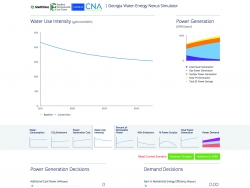New report highlights the impacts of Georgia’s energy decisions on water use
As climate change and a growing population strain Georgia’s water, and as the “water wars” with neighboring states wage on, the Peach State is currently on a path of greater water consumption from power production.
But to a large extent, the future is not yet written. That’s the message of a new report commissioned by SELC and Southface that explores the link between Georgia’s energy decisions and the resulting burden on water resources.

The way in which electricity is generated makes an enormous difference in terms of the amount of water consumed or lost in the process. As energy efficiency and solar – resources that use little or no water – continue to decline in cost, greater reliance on these resources in the decades ahead could significantly lessen projected increases in water consumption, while providing an array of other benefits.
The report provides the results of analysis completed using an electric power sector model that calculates projected water use and other environmental impacts. The study considers various potential future pathways for Georgia’s power sector and, using the model, estimates the water requirements, costs, and emissions of carbon dioxide and several air pollutants for each. Three of six potential future pathways examined involve increased investments in energy efficiency.
Each of the six potential future pathways shows that depending on the state’s demand for electricity and how this demand is met, Georgia has a wide range of outcomes for water consumption and loss. Based upon the analysis, SELC and Southface recommend several actions to support the state’s efforts to monitor and manage Georgia’s water-energy nexus.
First and foremost, Georgia should consider meaningful investments in energy efficiency as part of its energy planning efforts. Nationally, many states regularly achieve five to six times Georgia’s level of energy efficiency program savings, while Southern states like North Carolina and Kentucky handily best our energy efficiency performance. For both utilities and consumers, the benefits are clear: energy efficiency is cheaper, uses no water, and has zero emissions.
In addition, SELC and Southface recommend:
- Additional investments in solar: Solar uses almost no water and, like efficiency, produces no emissions. Georgia has emerged as a solar leader in recent years, but that success is overshadowed by neighboring states like North Carolina, which has more than six times as much solar. Paired with robust investments in energy efficiency, Georgia’s power sector could realize a significant decline in water consumption compared to 2015 levels.
- Need for consistent water withdrawal and consumption data: The report found that water consumption numbers for regions and sectors across the state were inconsistent and that the methods used to develop them were unclear. Addressing this information gap would sharpen Georgia’s already strong water planning efforts.
- Strengthen state water-energy planning practices through better coordination: Through better coordination between its water and energy planning processes, Georgia could meet energy demand while saving water for other key areas of economic growth, and better protecting and restoring natural stream functions.
“Energy planning decisions are often made in a vacuum, with little to no coordination with critical sectors such as water supply,” said SELC Senior Attorney, Kurt Ebersbach. “To be better stewards of our limited water resources, Georgia’s policy-makers need to understand the relationship between power generation and water loss. Increasing investments in clean energy resources like energy efficiency and solar can save water and promote economic growth in the state, while also protecting and restoring the ecosystem.”
Click here to read the full report: The Water-Energy Nexus in Georgia: A Detailed Examination of Consumptive Water Use in the Power Sector
